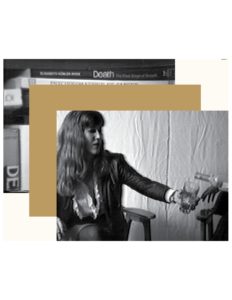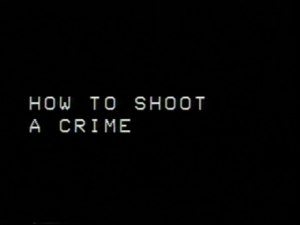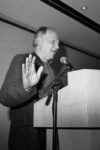 The following piece is excerpted from Take Shape, a new publication charting the waters of architectural, legal, and political thinking. Its first issue takes up the topic of industrial reuse, with a focus on lofts—residential spaces created from former commercial and manufacturing space, which provide affordable housing and often serve as a respite from the profit-driven real estate market. Simultaneously, lofts can be co-opted by property developers and local officials to justify rising rents and increased policing in newly “safe,” “artistic,” and desirable neighborhoods. Take Shape presents all of these factors side by side, seeing them not as contradictions, but as essential components of how such spaces function. For more information and to order a copy of the issue, visit takeshapemag.com.
The following piece is excerpted from Take Shape, a new publication charting the waters of architectural, legal, and political thinking. Its first issue takes up the topic of industrial reuse, with a focus on lofts—residential spaces created from former commercial and manufacturing space, which provide affordable housing and often serve as a respite from the profit-driven real estate market. Simultaneously, lofts can be co-opted by property developers and local officials to justify rising rents and increased policing in newly “safe,” “artistic,” and desirable neighborhoods. Take Shape presents all of these factors side by side, seeing them not as contradictions, but as essential components of how such spaces function. For more information and to order a copy of the issue, visit takeshapemag.com.
The indentation of a body remains in a light-green bed. Who knows where the sleeper has gone. There’s something scary about all this. The adult-sized, physical impression shows prior weight, heat, and the creasing of sheets. There’s something sexy about all this. The onlooker intuits the dreams and nightmares that occur in this room nightly. But who records this scene? 
Chris Kraus is the director of the short film How to Shoot a Crime, filmed in 1982, and completed in 1987. Shot by Marion Scemama, the video takes place mainly in a loft at 228 Front Street, near the developing South Street Seaport. The loft belonged to French literary critic Sylvère Lotringer, Kraus’s longtime collaborator and lover, who was then teaching a course at Columbia University on death and dying. Throughout the film, two narratives bleed into one another: dominatrices discuss their relationship with pain; and George Diaz, an NYPD videographer, walks through the process of creating documentary evidence for homicide cases.
Chris Kraus, a self-proclaimed “failed filmmaker,” accepted that her early videos would be appreciated mostly by friends and fellow artists. She is better known for her later work, especially her novel I Love Dick, which was recently adapted into an Amazon series. Upon the favorable reception of her books, the video art community began to reconsider her film work. Her writing, as well as her early film work, is driven by what Leslie Jamison describes in a recent New Yorker profile as “an abiding obsession with context” and the correlating desire to evade it.
Context, coincidentally, is the only part of Kraus’s early video experiments that can be easily found. While it is difficult to find How to Shoot a Crime online, it’s possible to find it described in essays and interviews with the director. The most thoughtful reflection on the film comes from her essay collection Video Green. She asserts that sadomasochism is “an enactment of urban displacement” because it represents “a desire to be someplace, to be locked in an intractable complicit transaction that takes place firmly in time.” This argument, indicated especially by the word “enactment,” suggests that sadomasochism is an actor in the play of urban displacement — a metaphor that is far-fetched, but perhaps valuable.
The roughly half-hour-long film opens with an isolated shot of leather boots and a young woman’s voice. “When you’re a control freak . . . when you’re a control maniac . . . ,” Terence Sellers says, as the camera moves slowly up her body, clothed in dark colors. The camera pauses on her red lips, pronouncing that the worst problem is not being able to “hear” other people, and that she is more intuitive when she’s drunk. “You have to feel,” she drawls, as the camera drops back down to her hands, where she fiddles with the sunglasses in her lap. Lotringer and a woman off-screen ask Sellers questions that she chooses to ignore—ironic, considering the content of her speech. There is a studio backdrop, but the unflattering ambient lighting hints that she’s not in a studio, which is confirmed when the camera reveals the edges of a white sheet hanging on the wall behind her. The half-hearted attempt at generic film backdrop falls away, revealing a casual home setting.
Why pretend in the first place? The false backdrop shows certain flexibility and lack of structure on the part of the filmmaker, evincing Kraus’s obsession with simultaneously needing and avoiding context. A viewer might assume that the location of the interview isn’t important, but Kraus goes out of her way to show that it isn’t where it appears to be. It’s surprising, then, how seriously she discusses the dominatrices’ lack of connection with the outside environment in the Video Green essay collection:
Inside the loft on those long days in 1982, the two women on screen are intent on self-probing, not listening or looking around them. They are highly atomized single units, barely conscious that they are operating within an environment. And as such, they are emanating everything important about that environment. They are emanating anxiety, longing and fear.
That the women ignore their surroundings is true at face value; yet it makes sense, given that Lotringer asks questions that are largely philosophical in nature. Why would they talk about their surroundings when they’re being asked about themselves? In fact, there are moments when the women assert control over other aspects of the interview. At one moment, the other dominatrix, Mademoiselle Victoire, refuses self-probing and flips the rote Q and A format. As Lotringer asks her about a movie he recently saw, she raises her eyebrows and declares that using a camera creates a detached, one-sided understanding of pain. “We need your dick out here,” she asserts. A few vignettes later, and the camera moves across the spines of Lotringer’s bookshelf. The title of each philosophical work indicates its content: pain and death. Lotringer asserts that a scholarly understanding of pain is necessary so that people don’t lose control. Victoire doesn’t argue with this, but she smiles knowingly. Despite his cool demeanor, the interviewer, who has no personal experience with sadomasochism, is the one being controlled.
***
Beyond the confines of the dimly lit loft, establishing shots provide a broader understanding of the film’s time and place. In an early scene, Kraus delineates the Lower Manhattan skyline, presumably from the roof of Lotringer’s apartment. As the camera skims over various high-rises, the voice of a dominatrix speaks over the images. She muses on how she feels when she views footage of a murder scene, and her shock at the pain that one human can impart on another. The buildings show the surrounding neighborhood more clearly—the construction of speculative finance, the new luncheonettes for stock traders, and the deteriorating facades one street over. Subtitles flash: “A Film, A Crime, A City.”
The city is New York, specifically the area near the South Street Seaport. As the Reagan administration’s deficit spending paved the way for a building boom, developers in this part of Manhattan began unveiling new multimillion-dollar structures on a regular basis. By late 1985, the indoor mall at Pier 17 was open for business, and the surrounding area was slowly converted into a festival marketplace. Leadership at the local museum raised funds to partner with developers and historic preservationists to use the setting of a fishing port as an attraction for tourists and people who worked on Wall Street.
In one scene of the film, an apathetic Lotringer speaks with the perky financial manager of the South Street Seaport. She says that the fish market and the retailers operate on opposite schedules, allowing shoppers to feel that they’re in an authentic environment without actually interacting with fishermen and women. “Prices have really skyrocketed . . . It’s the hot new neighborhood in town,” she concludes.
By the 1970s and ’80s, decades of white flight and industrial sector job depletion had taken their toll on Lower Manhattan. Lack of demand from the wealthy caused banks to stop providing loans to landlords and property developers in the area. Many building owners stopped paying taxes on these properties or abandoned them altogether, leaving them to in-rem forfeiture, under which they eventually became property of the city. By 1987, 4,500 buildings in the area were in the city’s possession, and squatters took control of many empty buildings. Until legally recognized through urban homesteading initiatives, many residents feared legal repercussions. This repossession occurred in tandem with a spike in the economy that increased rent in areas like the Seaport, which were of interest to developers. By the time How to Shoot a Crime was completed in 1987, some residents in the area were no longer squatters, but people paying relatively high rent.
***
Kraus puts forth the thesis that a fascination with violent crime is a symptom of income inequality within close proximity. This idea is shown in the third major strand of the film: New York homicide videography. A bearded, forty-something man named George Diaz is shown for a brief moment, wearing a blue t-shirt and jeans that accidentally match. His presence beyond this moment takes the form of a voice that speaks over videos he creates for juries in homicide cases. Since most murders take place in the victim’s own apartment, he says that he likes to first show the victim’s circumstances—their spaces, memorabilia, etc.—before showing the dead body. He does it in this order so that the jury have “whet their appetite and they want to see the body.” He mentions the entertainment of pain, but does not linger upon it. It becomes clear that, for the film, cathartic viewership is what links murder to sadomasochism.
These two forms of violence are linked provocatively when the dominatrix Sellers says that causing pain always comes from the same impulse. She says that she imparts pain at fifty percent, whereas a murderer imparts pain at one hundred percent. “It’s the same thing, the same impulse,” she intones, as the film cuts to a shot of a coroner lifting the sheet off of a murder victim’s body. This would appear to be a serious conclusion, yet in Kraus’s Video Green essay collection, she describes Sellers in this scene as “stoned and wanting to be a philosopher.” It points to the sense of apathy that pervades the video—from the poorly placed backdrop curtain to this apparent thesis of the film.
Rather than deeply connecting sadomasochism with gentrification, the film shows how removed loft living can be from issues of displacement and crime. During the 1970s and ’80s, a crime-ridden New York was a popular trope of journalism, with headlines like the London Sunday Times’ infamous 1973 front page story, “Thugs, Mugs, Drugs: City in Terror.” Movies like Taxi Driver (1976) also depict New York as a homogeneously dangerous place. While it’s true that violent crime was at an extreme high during that time, it’s untrue that all New Yorkers were affected equally. People (mostly men) who paid for dominatrices and rented South Street Seaport lofts were not likely to be the same people most at risk of homicide. According to a 1986 homicide report published in the American Journal of Public Health, the vast majority of homicide victims in Manhattan during that time were young black men, a demographic that is never shown in How to Shoot a Crime. Lotringer’s apathy and critical detachment pushes a philosophical understanding of violence that is disconnected from the realities of crime and displacement.
The stakes of passive viewership of crime comes to a head in the final scene of the film. Diaz says that a murder has taken place at 228 Front Street, Lotringer’s own building. He shows the scene outside—a red brick building with a restaurant on the street level. He climbs the stairs slowly, eventually entering the apartment. A kitchen is shown, with ample wine glasses on the drying rack, ready for hedonistic nights to come. When Diaz enters the bedroom, a bald man in a brown “North America 83” t-shirt is lying on a bed with his arm twisted backward, apparently dead. The camera pans over details in the room—half-full handles of alcohol, a knife, and some books. When the bed is shown again, the body is no longer there, but the indentation of a sleeping body remains. The camera turns toward the corner of the room, where the man who was supposedly just dead is now suddenly standing. He looks at the viewer, tongue-in-cheek; not resurrected, but quietly smirking.
Nolan Boomer is an art and architecture writer based in Hudson, NY. He is currently an editorial assistant at Princeton Architectural Press. nolanboomer.com
This post may contain affiliate links.









